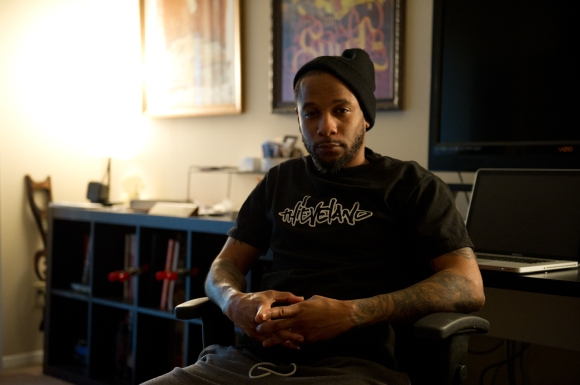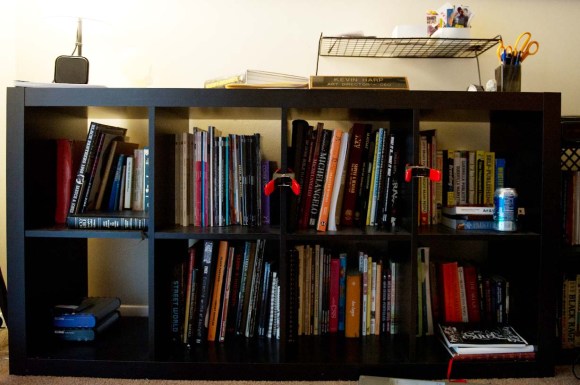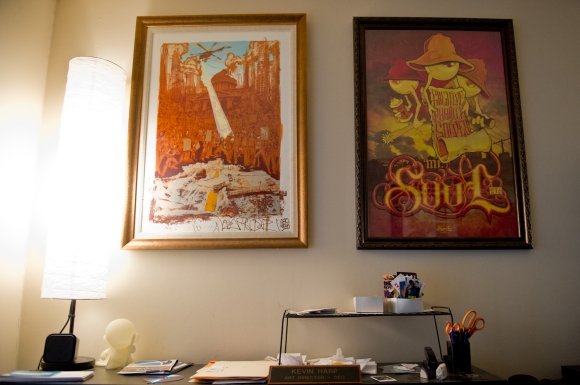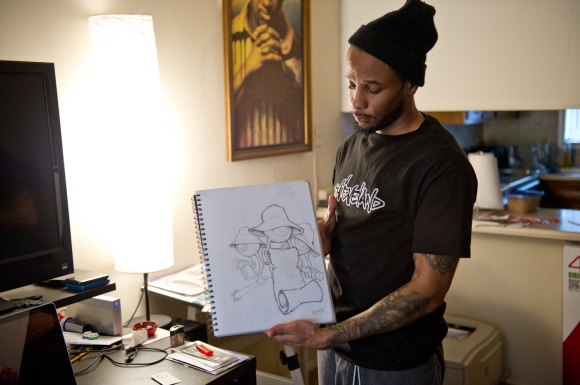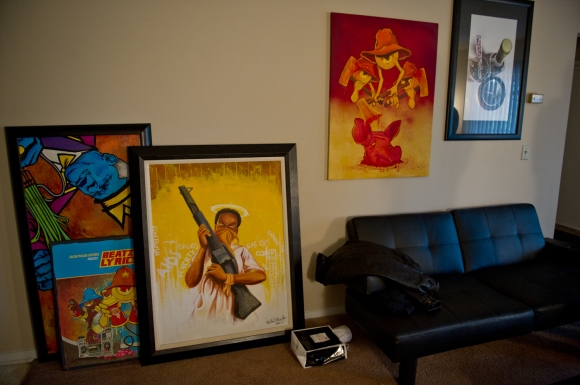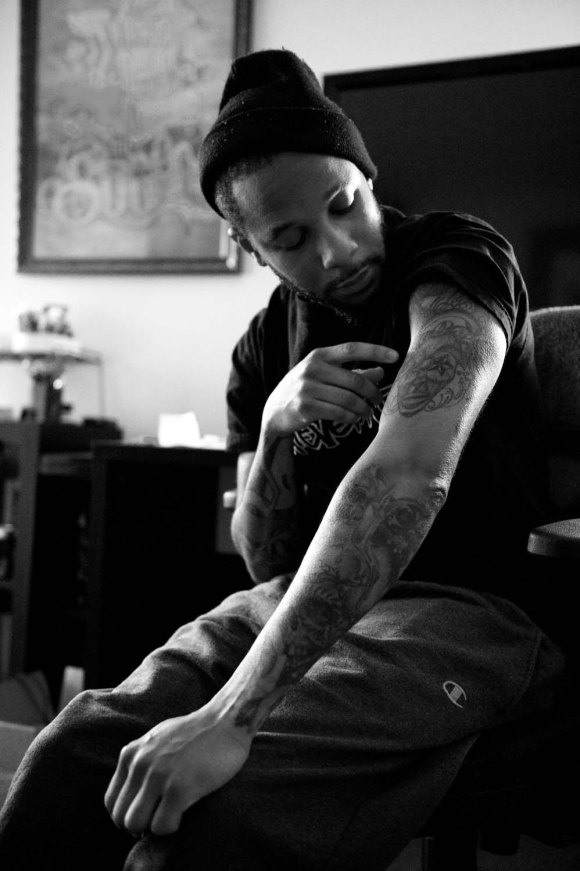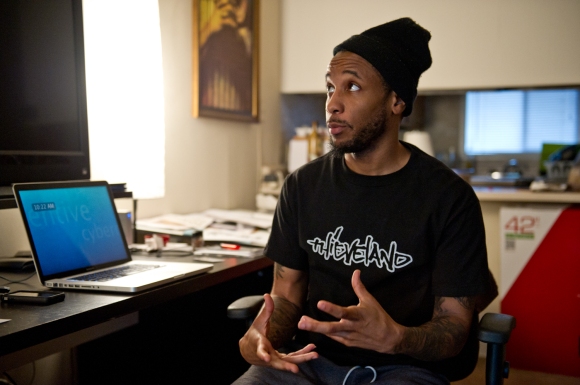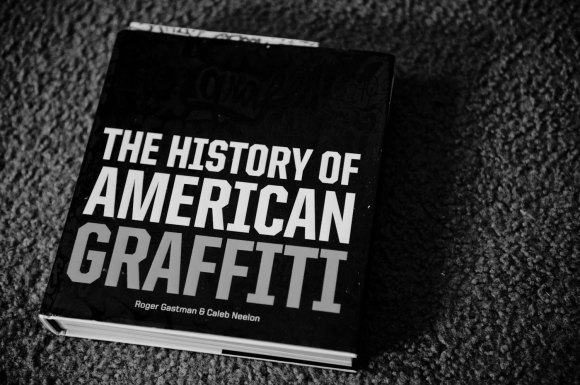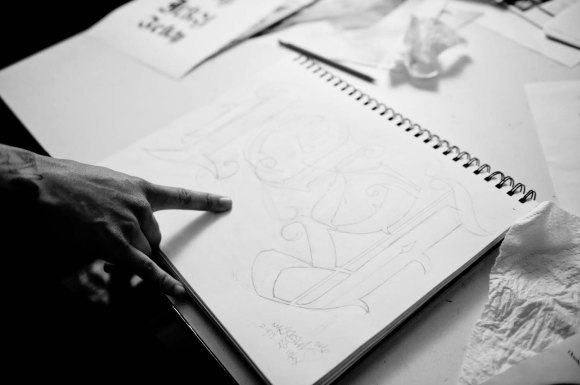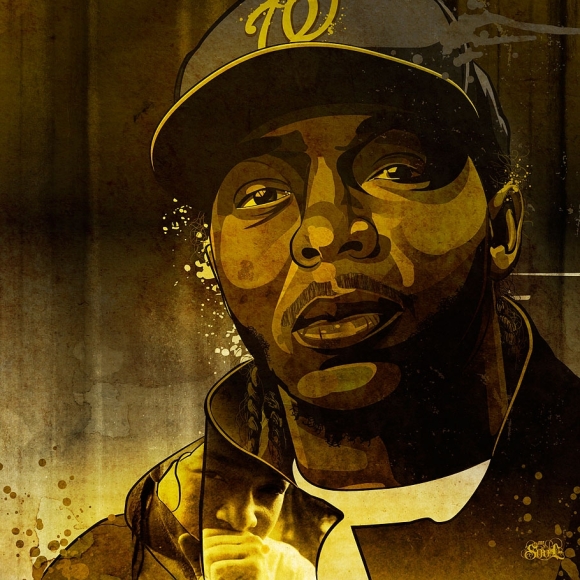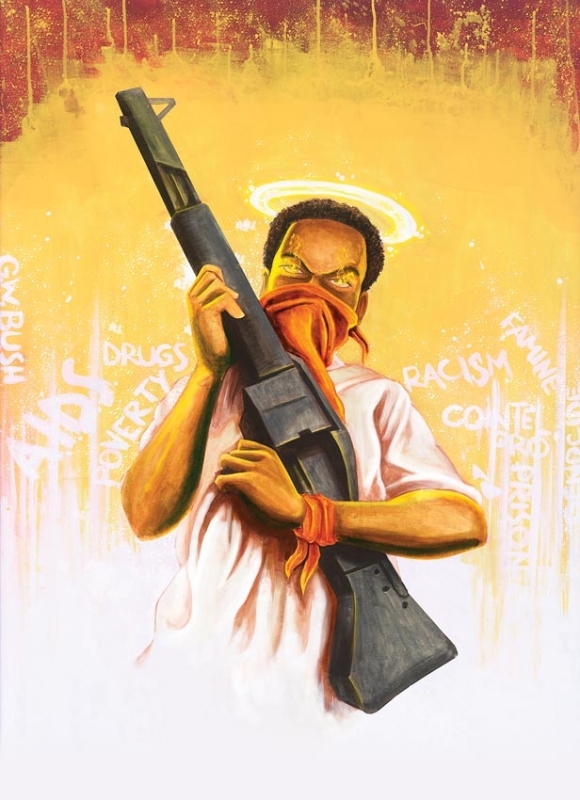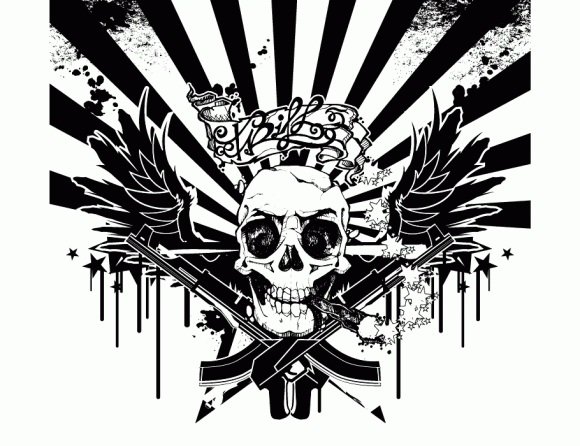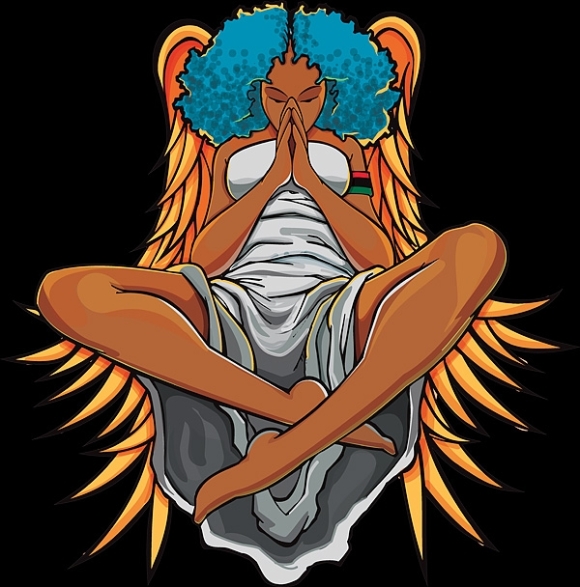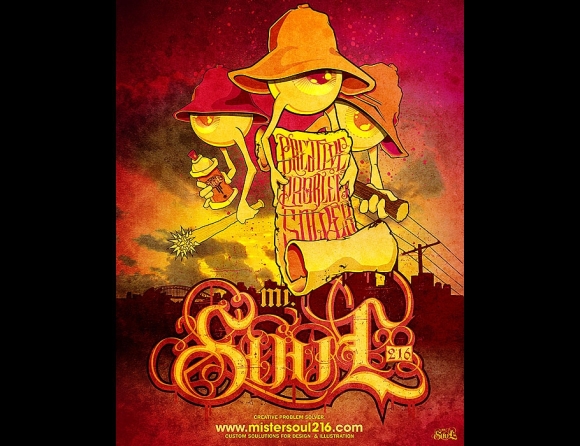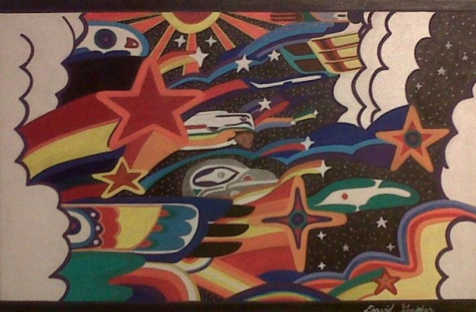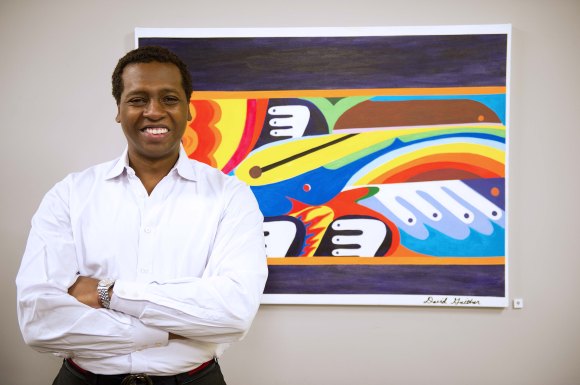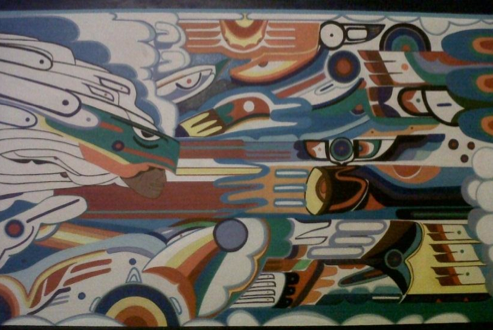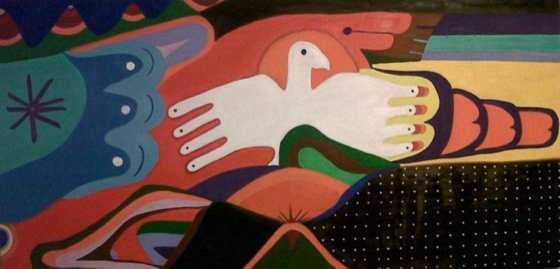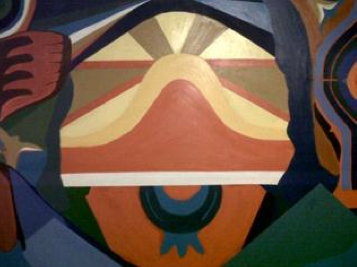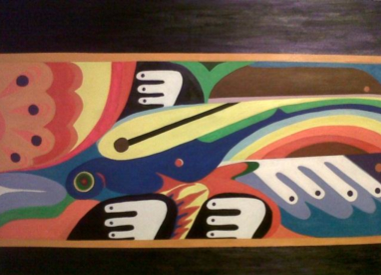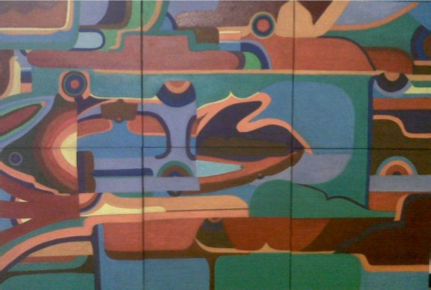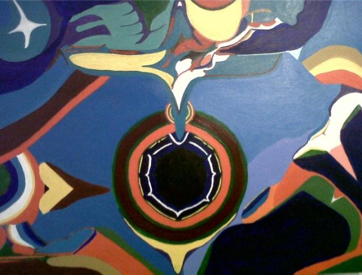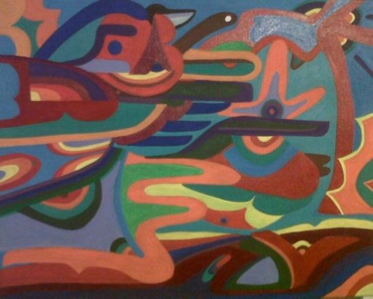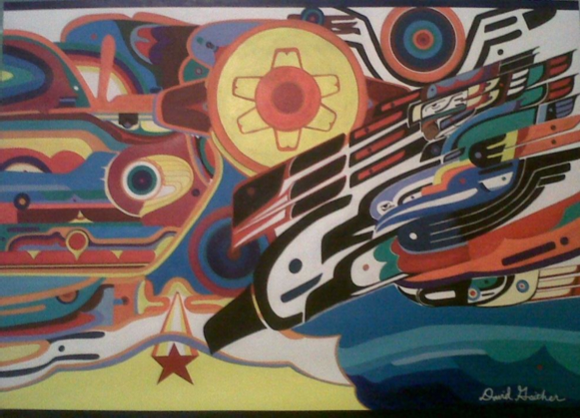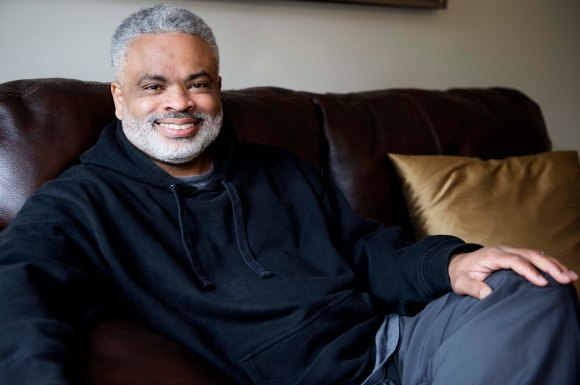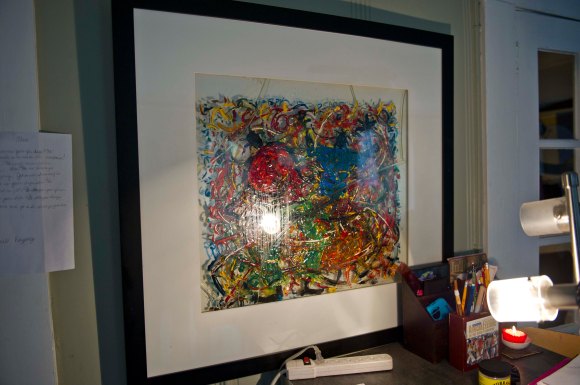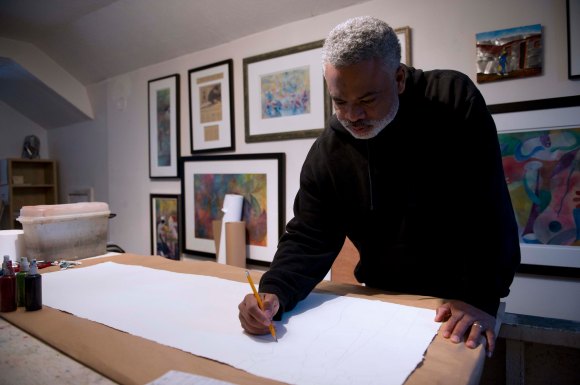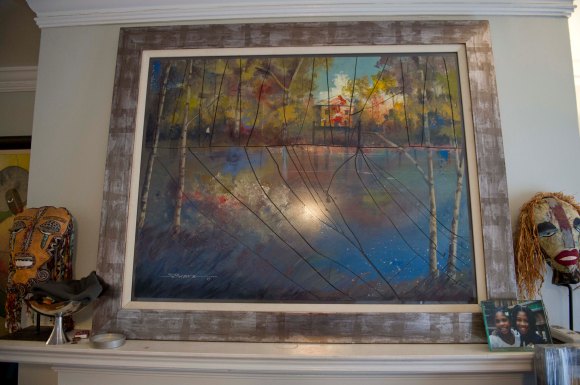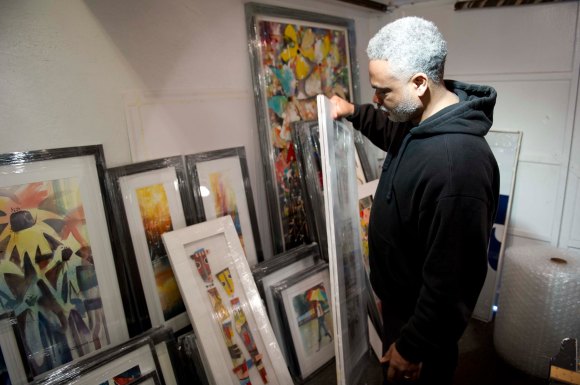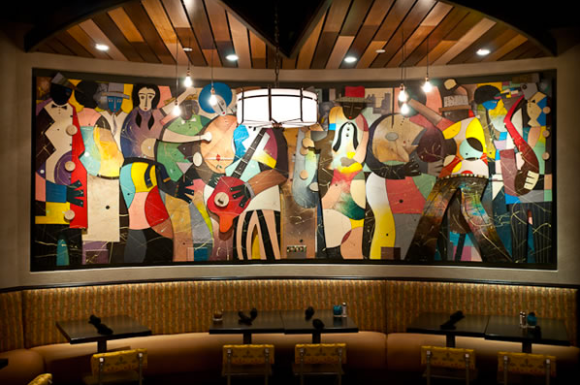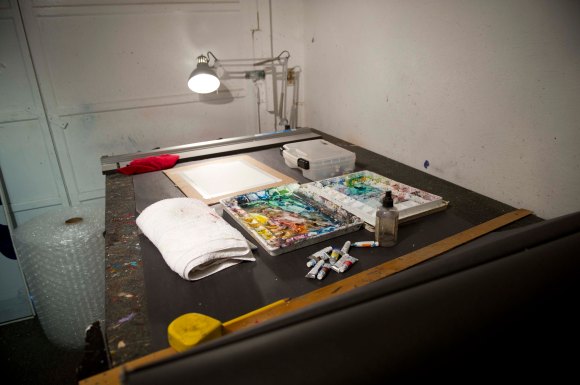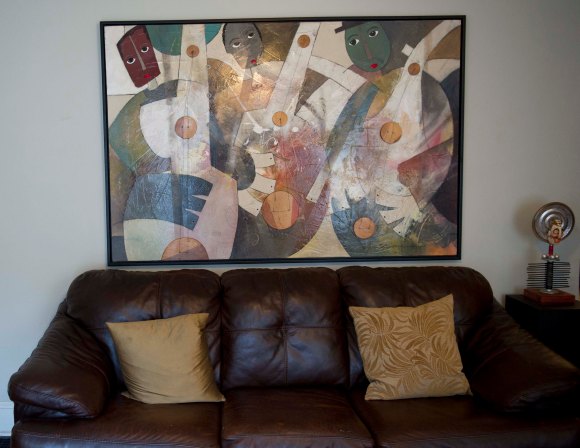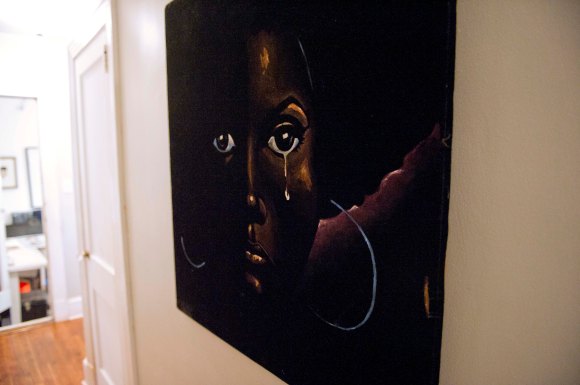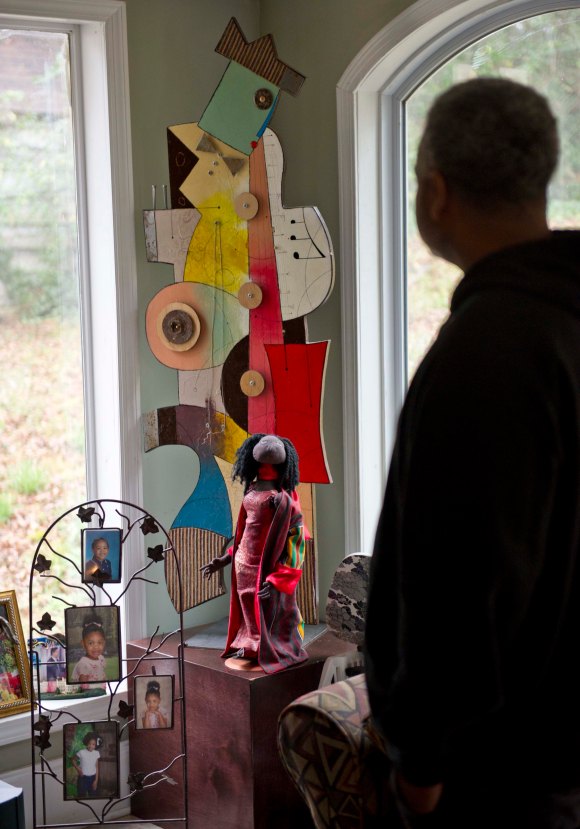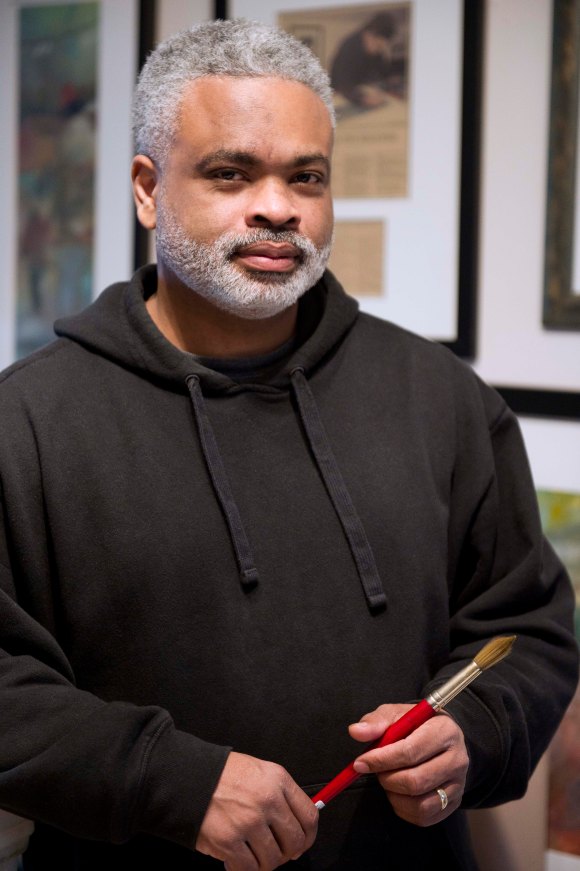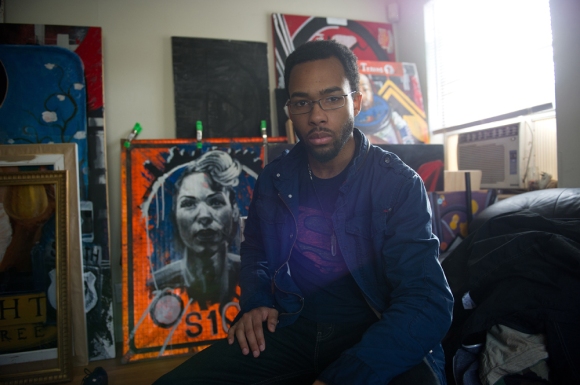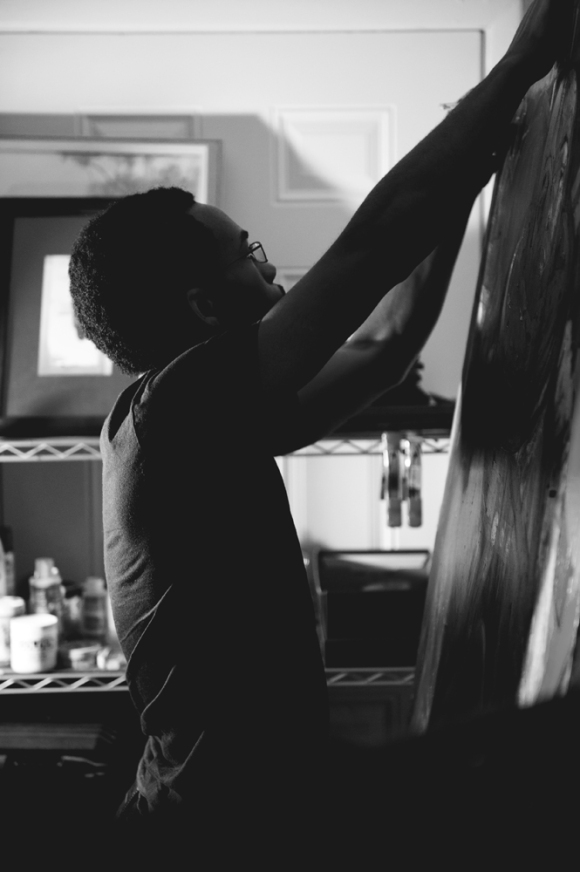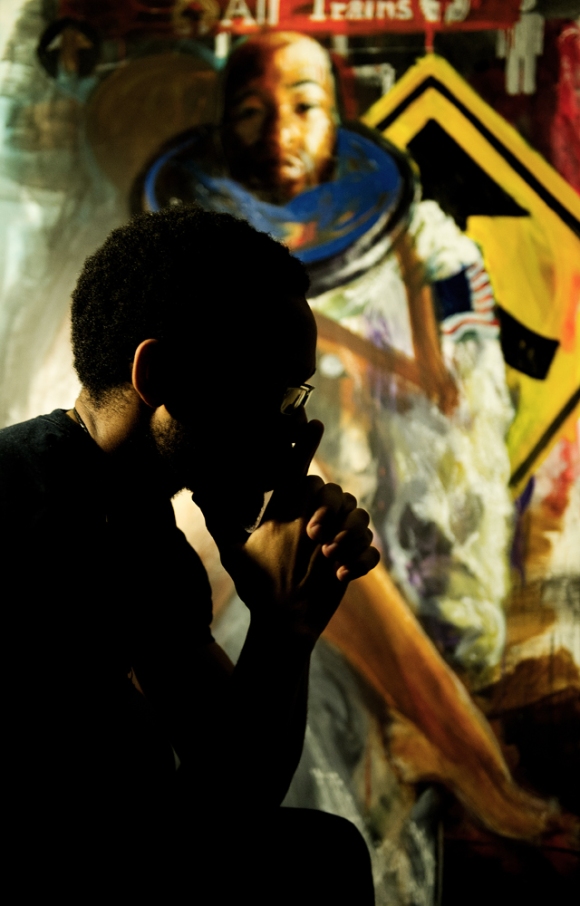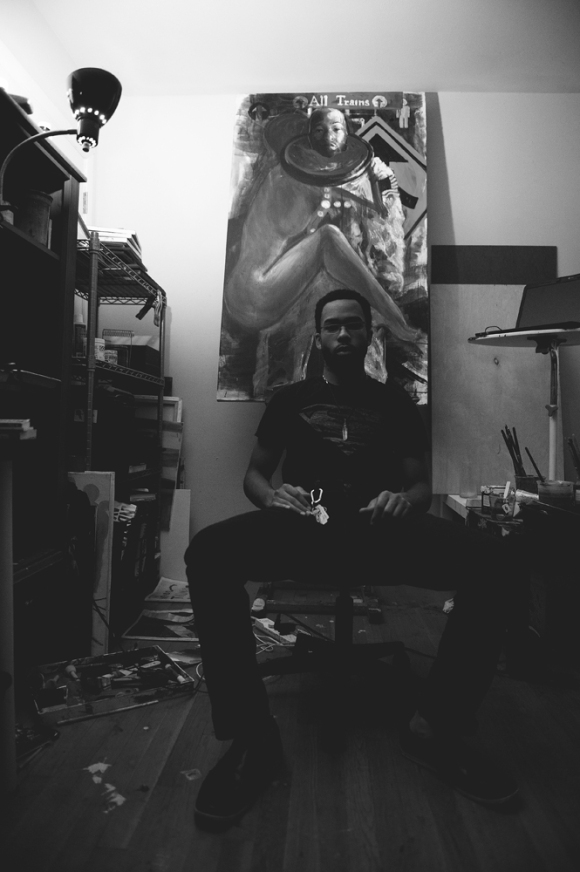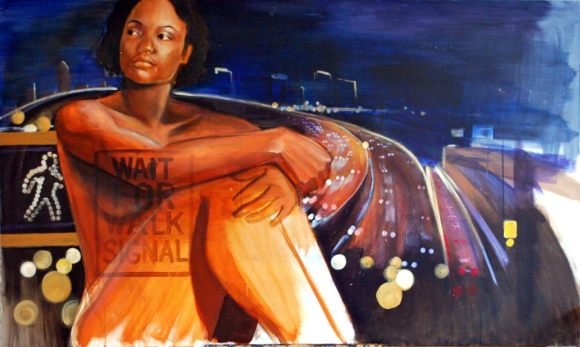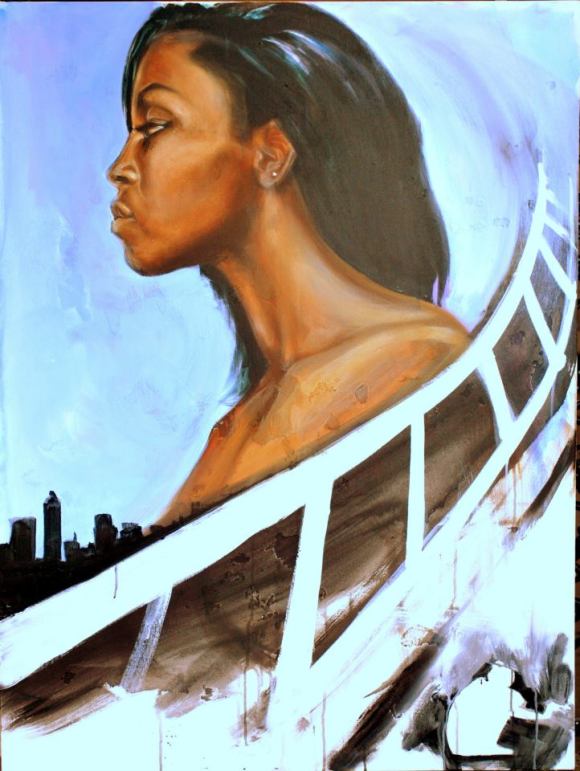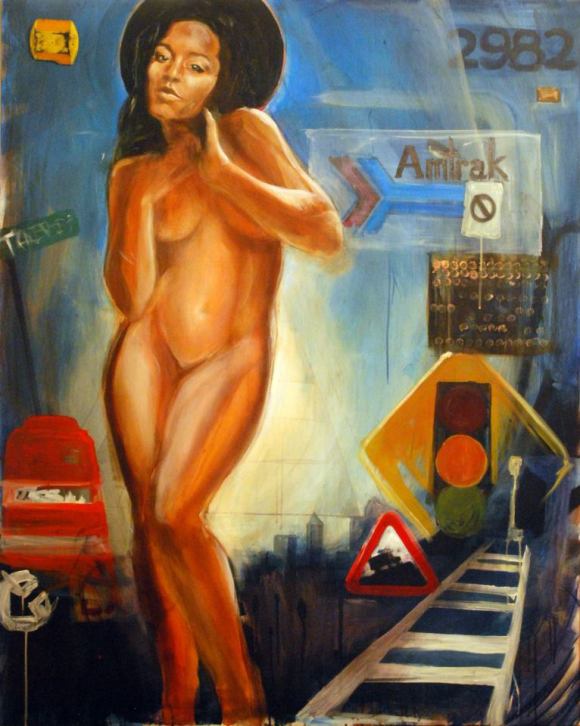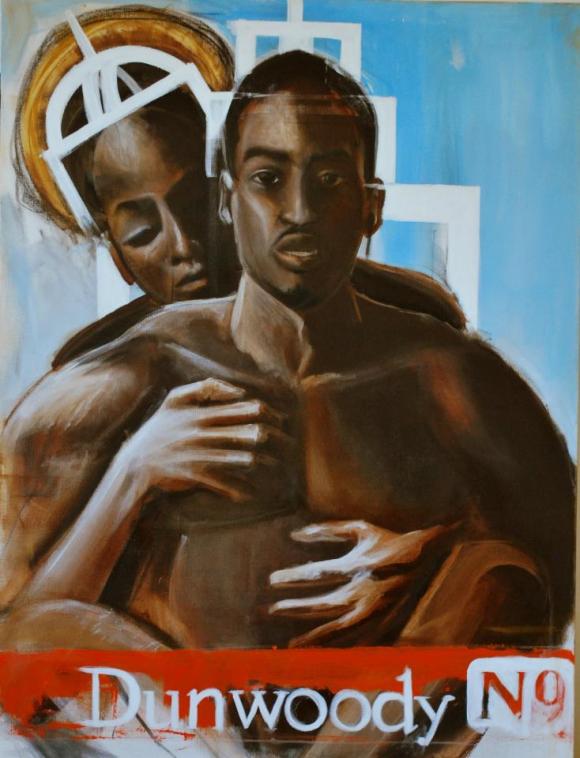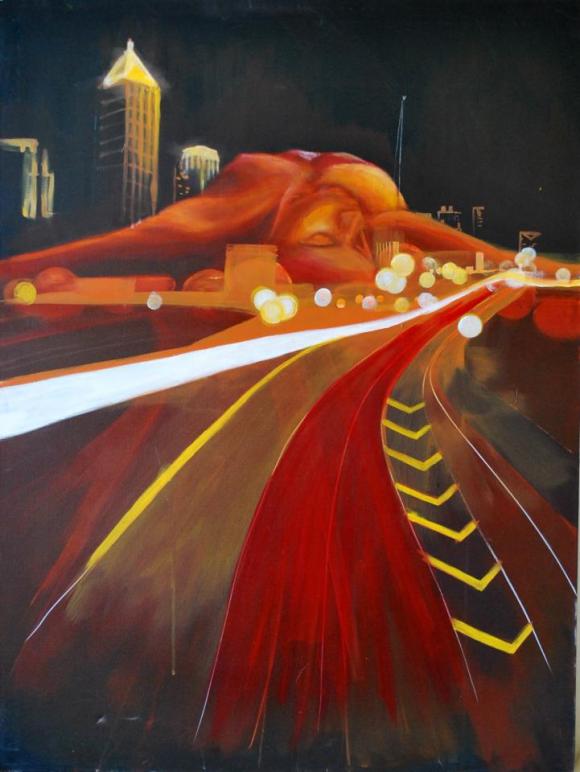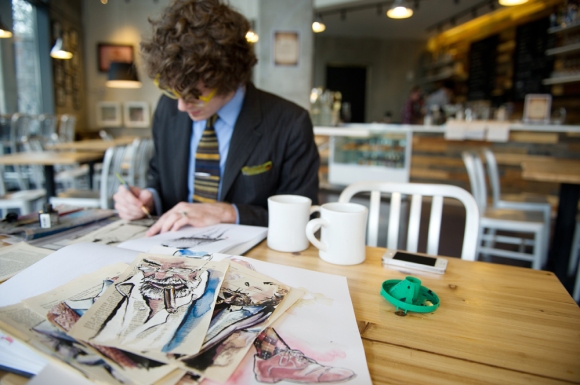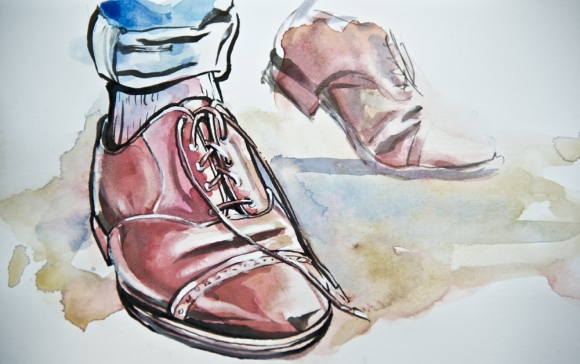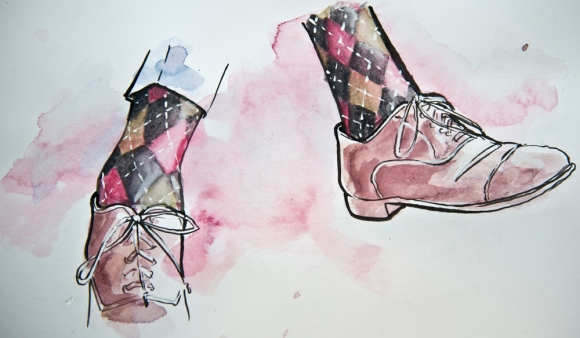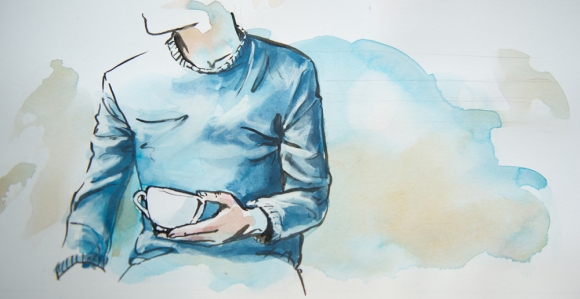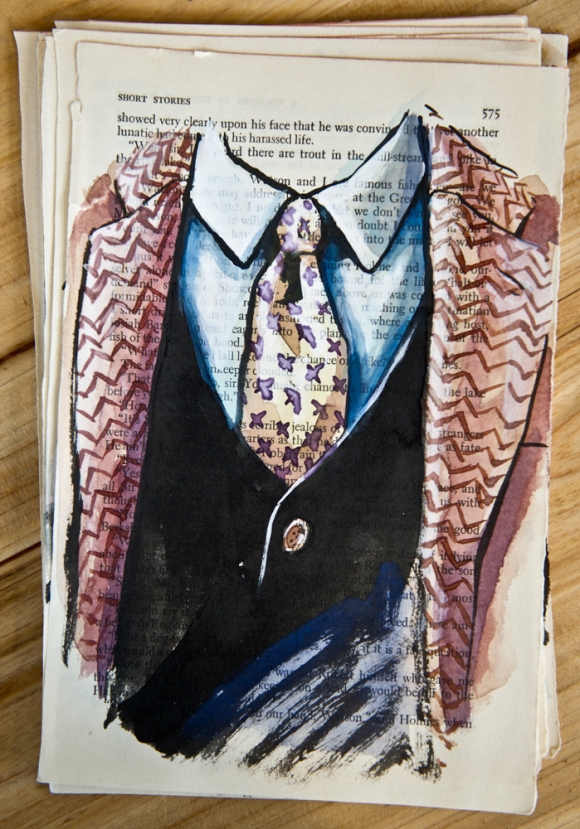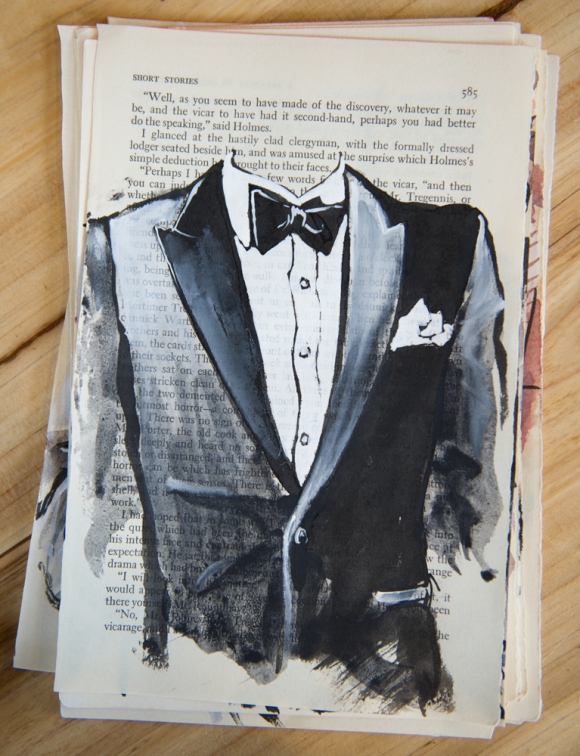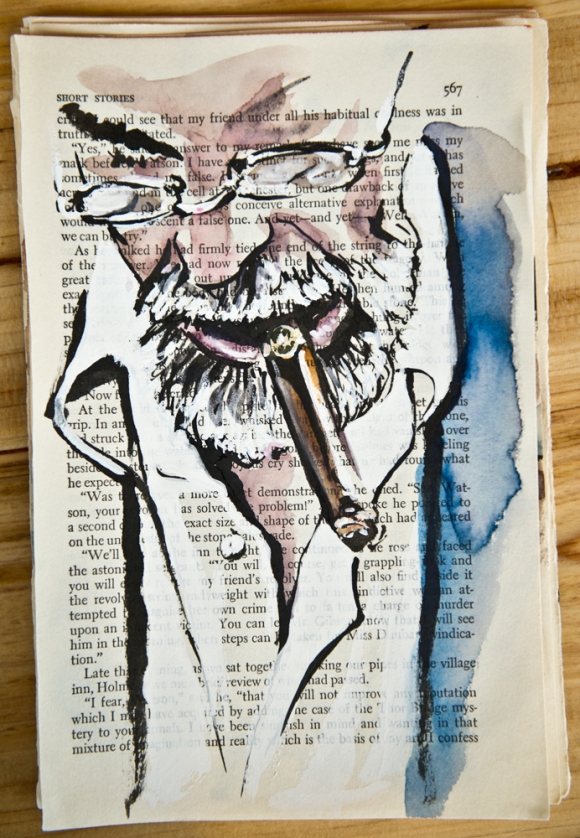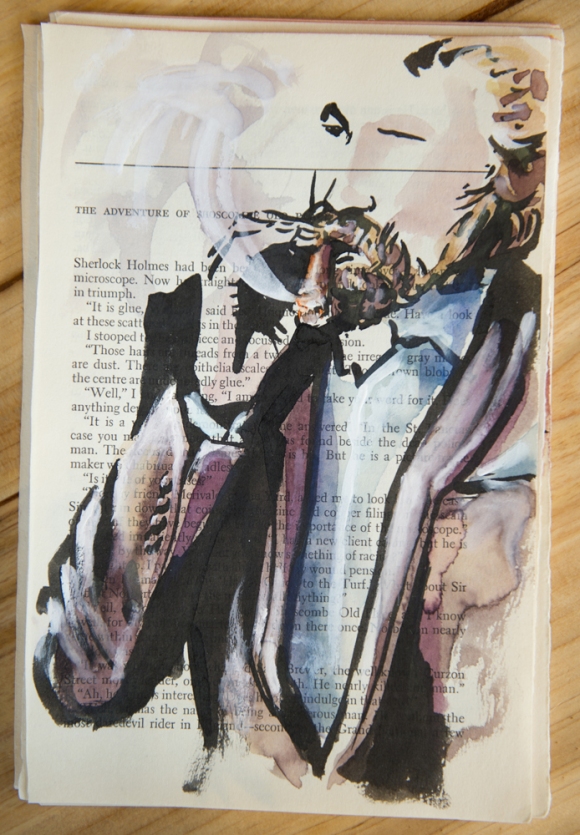Grey day. It’s raining. I want to sleep in. But I can’t. Because today—today—I’m meeting Mr. Soul. Yes, Mr. Soul. What should I expect? I have a mental picture—like you get with deejays on the radio. I’m picturing someone really cool from the mid-seventies—complete with afro—someone who wears sunglasses indoors. I head west of Midtown to meet Mr. Soul and find out. The door to his apartment opens… I’m greeted by an African American man in his late thirties wearing a Thieveland tee. His stocking cap is tilted sideways. He’s wearing grey sweats. We shake hands. His arms are heavily tattooed. On the left arm I see Harriet Tubman smiling up at me and also an eyeball collage. On the right arm—the portrait of a friend. This is Mr. Soul—also known… on occasion… as Kevin Harp—Art Director and CEO—so reads the brass plague on top of his fully stocked bookshelf.
First thing’s first. Before we talk art—I have to know about the name. How did Kevin Harp (formerly of Cleveland Ohio) become Mr. Soul? “I went through a lot of stages with the names,” he says. “I started out as Clue. Maybe because I had no idea what name to give myself.” Next? “Skript—it was a cool name—dope—something I could tag. Then I hooked up with DJ Centipede. He was a client in Cleveland.” At the time, Soul was putting out fliers for the popular Hip hop DJ. All the fliers were tagged with Kevin’s business name—Visual Soul. “Whenever Centipede would call up to talk business, he’d say, ‘Soooul.’” Kevin pitches his voice lower—in imitation of Centipede, holding out the name for a couple of beats. It stuck. “It was a way to identify me and my business at the same time.” It also ties in music, too. Music has provided a vital and lasting inspiration in Soul’s life as an artist and as an individual. His favorites? Marvin Gaye, Gladys Knight and the Pips and Outkast to name a few. “I like for my visuals to match the sound—soul, ghetto, gospel. I’m really inspired by funkadelic. It’s the type of feel I want in my art—that sort of movement and energy.”
Now we can talk art. There’s a poster on Souls’ wall. Three eyeballs stare down at me. They have arms. They’re floating above a shadowed, urban landscape beneath a mottled orange and yellow sky. The left eye wields a spiked mace and a spray can. The right eye—a stick. The central eye holds an unfurled parchment in its hands. Emblazoned on the scroll in ornate, red script are the words, ‘Creative Problem Solver.’ All three floating eyeballs are rocking Kangol hats. The bottom of the poster is emblazoned with the name ‘Mr. Soul’ in an ornate, Gothic style script. “That’s one of my classic eyeball pieces,” Soul says. I’m getting a sort of mystic feel from the eyes—maybe it’s all the Hindu mythology I’ve been reading lately. “They represent the three pillars of life,” Soul says. “Mental. Spiritual. Physical. Without all three you get off balance. The center eye represents the third, all seeing eye—the ability to have visions—to see more than what’s perceived by your ordinary senses.” Cool. I wasn’t so far off after all.
“I love to work in layers. For me, that’s one of the draws of Adobe Illustrator.” I look at the poster again. Literal layers. Metaphorical layers. An inner eye rocking a Kangol hat. He shows me the original eyeball sketch. The final piece is super smooth. It’s a crisp, deftly handled graphic work. It looks effortless. “That’s because you’re seeing the final product,” he says. “You didn’t see the times I punched the wall in frustration—the times I hit ‘undo’—and the two hundred pieces of paper I wadded up to get here.” So how does he get from the initial sketch to the final, poster sized image? “I take a picture of the sketch with my phone and then dump that into the computer. I used to use Photoshop; but I’d say I’m 90% Adobe Illustrator now.” Why? “I love the clean lines—the scalability. You have to have a certain skill set to use it. Not everybody can. Every piece is a challenge. I have a vision in my head; but then I have to hash it out in Illustrator terms. There’s four or five ways to skin a cat—sometimes you just have to combine a few of those ways to get the cat fully skinned.”
How early did Mr. Soul get into art? He laughs. “I came out of the womb with a box of crayons and a pack of construction paper.” Talk about being prepared. “I remember my first grade art teacher—Alice Cooper. She showed us how to create intricate scenes out of primitive shapes—circles, squares, triangles. I was fascinated.” There was no going back. He has another childhood recollection. “I also had an older cousin. He was into comic books and kung fu—Spider Man, Batman and Bruce Lee. I lived in his shadow from about first to fourth grade. Mom said I used to cry because I’d get so frustrated that I couldn’t do what he was doing.” Nowadays, of course, Soul gets to do what he wants. He’s out of the shadows. But it was a long road to Atlanta. So how did he get here?
“By sixth grade, I knew I loved art. But I didn’t know what direction I should take. In high school I did a lot of airbrushing on tee shirts and jumpsuits.” He and a few friends also had plenty of encouragement from a gifted, local graffiti artist—Sano. Sano? It stands for Super Notorious Artistic Outlaw. “Well, that was one of the meanings,” Soul says. “He was a big brother, a father, an uncle to me. I used to ride the Red Line. I’d see his pieces out the window and I knew I wanted to be a part of that. I remember I’d cut school and go to Sano’s house. We’d go steal art supplies from the store.” Fear not, gentle reader—the purloined goods were put to good use by Soul and his mentor. “He taught us how to use markers, airbrush and computers. He helped set me on my way.”
Before Atlanta, Soul spent some time in Pittsburg. He’s a graduate of the Art Institute of Pittsburg. He stops me before I can ask about his major. “Don’t ask what degree I got—I haven’t ever used it.” But the sojourn to Pittsburg wasn’t a total bust. He linked up with some notable graffiti artists. He rattles off a whole list of names—superstars of the graffiti world. I’m totally lost—scribbling down names—trying to keep up. Does he notice? Yes. Soul’s kind enough to stop and give me a brief spelling tutorial. He’s patient about it, like an adult teaching a little child to sound out a new word for the first time. It’s then I realize—there’s a whole artistic movement I’m barely aware of. My graffiti name would be ToWS—Total. White. Suburbanite. I am Clueless. But not for long. He pulls a book off his shelf—The History of American Graffiti by Roger Gastman and Caleb Neelon. It’s all documented here—the long, rich, innovative history of graffiti art. Mr. Soul turns up in the pages, too. There’s hope for me, yet.
“I’m coming up on year seventeen here in Atlanta.” He came for the art. “In Cleveland, outside of the steel industry, there was no means of survival.” Back in Cleveland, Soul worked on a hip hop newszine—The work brought him to Atlanta in ’95. “It was the last Jack the Rapper convention,” he says. “We were going to take that energy we felt here back to Cleveland. But in the end, we still got the lights shut off—the rent was still late. There was just no infrastructure to do it.” So in November of 1996, Soul came to Atlanta. The early days were slim. “A partner and I came to Atlanta to look for a place to live and for work. We stayed at the Days Inn for a week, eating Waffle House for breakfast and dinner until we got leads and secured a place to stay.” But Soul stuck with it. He looked with his inner eye and found his way. “Everybody’s got a purpose. But most people just don’t know how to find it. I was lucky. The light was shining in my direction. It was destiny.”
Aside from his art, Soul does a lot of work with students in the community. “I get calls from my friends—‘Kevin, help, my son’s scribbling all over the floor—what do I do?’ Art is intriguing to every child. So I go to local schools and talk to the kids. I have to. Arts funding is being cut everywhere. It’s ridiculous. We’ve got plenty of money to bomb other countries—but we can’t have art class in schools?” He’s trying to give these kids a chance he didn’t have as a kid growing up in Cleveland. “On career day, we’d have a lawyer come in, a police officer and—” he laughs, “ a dentist.” No artists with tattoos. “When these people come in to talk to kids they fall asleep. There’s a big disconnect between them and the police officer who comes to talk to them.” But with Soul they get a different perspective. “I come in—hat to the side, tattoos—looking like what they want to be. But at the same time, I articulate how important it is to be in school—to stay in the books—to listen to their elders, their parents, their teachers. We show them that they can still be themselves—you can have tattoos, even—and still be a productive member of society. Because, let’s face it—at the end of the day—these kids want to be like us.”
At a local Castleberry Hill gallery, Soul challenged parents to let their kids put down their own ideas concerning the execution of Troy Davis. “Too often we don’t listen to kids. We don’t let them speak their minds about a situation. We tell them, ‘You can’t say this. You can’t do this. You can’t know this until you’re this age.’ But, by then—it’s too late.” Soul encouraged them to speak. And they did. Each child drew a picture of his or her interpretation of the events surrounding the Davis execution. Then they wrote paragraphs explaining what their pieces meant to them—in their own words. “The event went beyond race and class,” Soul says. “It was about the kids. Letting them speak their minds—and us listening.”
Soul’s also active up at City of Ink—the urban tattoo shop located at 323 Castleberry Hill. There’s a lot of great art being produced up there. His arms bear witness to this. He’s fervent about black tattoo artists getting the respect they deserve. “There are a lot of up and coming artists there—some as young as twenty two and twenty three years old,” he says. “Very talented. The tattoo industry as a whole can be very racist. Most people don’t realize it, but there’s an art and a science when it comes to tattooing on black skin.” He gives me a closer look at the Tubman tattoo. It was done by legendary tattoo artist Miya Bailey, co-owner of City Of Ink. “For me, having tattoos is like collecting art.” Soul has a pretty good collection so far.
Currently, Soul and some other artists from the Castleberry Hill circle are also working on a newsletter. He calls it a guerrilla grass roots effort. “It’s a diverse group of artists. Nobody comes from money. But we all come together. Makes us stronger—” he laughs, “like Voltron—it’s really a chance to try and professionalize our movement.” As for the near future, Soul’s artist’s plate is pretty full. He’s got a cancer awareness project lined up for the end of March. In April he’ll be working on a 420 show for the stoners. And in June—a black pin up show. Cool. He’s also got some personal projects, too. He shows me a sketch he’s been working on. It’s the text for a memorial piece in honor of one of his friends. It’s a collaborative work. His fellow artist, Goldi Gold, is working on the portrait to go with it.
With his current success, what does Soul have next in mind? “I’m sort of going backwards,” he says. “I started out exploring life through Fine Art. With Graphic Design, I’ve gotten a little off track. I want to work on some more personal expression. But you’ve got to keep the lights on. It’s a Catch 22—business versus purpose. But I’m finally at the point in my career where I can say, ‘No.’ Early on, I took every job I could get. I’m not everybody’s creative savior anymore—only those with a budget to be saved. I’ve finally got time for more personal work.” And if Soul could be anywhere he wanted—where would he like to be? He answers so fast, I know he’s already been thinking about his escape. “I wouldn’t be on a phone. I’d disappear for four or five days to some cabin in the woods—come back with a shit load of art—One with the earth again.”
From the wall behind him, the wise inner eye—half veiled by an orange kangol hat, looks down approvingly.
You can visit Kevin ‘Mr. Soul’ Harp at www.mistersoul216.com





